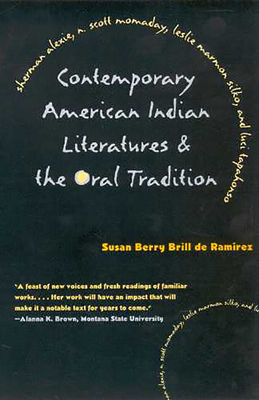
Contemporary American Indian Literatures and the Oral Tradition
Paperback
ISBN13: 9780816519576
Publisher: University of Arizona Press
Published: Jul 1 1999
Pages: 272
Weight: 0.88
Height: 0.70 Width: 6.14 Depth: 9.26
Language: English
. To demonstrate this point, she explores literary works both by established Native writers such as Sherman Alexie, N. Scott Momaday, Leslie Marmon Silko, and Luci Tapahonso and by less-well-known writers such as Anna Lee Walters, Della Frank, Lee Maracle, and Louis Owens. Through her literary engagements with many poems, novels, and short stories, she demonstrates a new way to read and understand the diverse body of American Indian literatures. Brill de Ramírez's conversive approach interweaves two interconnected processes: co-creating the stories by participating in them as listener-readers and recognizing orally informed elements in the stories such as verbal minimalism and episodic narrative structures.
Because this methodology is rooted in American Indian oral storytelling traditions, Native voices from these literary works are able to more directly inform the scholarly process than is the case in more textually based critical strategies. Through this innovative approach, Brill de Ramírez shows that literature is not a static text but an interactive and potentially transforming conversation between listener-readers, storyteller-writers, and the story characters as well. Her book furthers the discussion of how to read American Indian and other orally informed literatures with greater sensitivity to their respective cultural traditions and shows that the immediacy of the relationship between teller, story, and listener can also be experienced in the relationships between writers, literary works, and their listener-readers.
Also in
Literary Criticism
How to Read Literature Like a Professor: A Lively and Entertaining Guide to Reading Between the Lines
Foster, Thomas C.
Paperback
Jane Austen's Bookshelf: A Rare Book Collector's Quest to Find the Women Writers Who Shaped a Legend
Romney, Rebecca
Hardcover
Romeo and Juliet: No Fear Shakespeare Side-By-Side Plain English
Sparknotes
Shakespeare, William
Paperback
Taylor Swift by the Book: The Literature Behind the Lyrics, from Fairy Tales to Tortured Poets
Tatreau, Tiffany
Feder, Rachel
Hardcover
Julius Caesar: No Fear Shakespeare Side-By-Side Plain English
Sparknotes
Shakespeare, William
Paperback
A Swim in a Pond in the Rain: In Which Four Russians Give a Master Class on Writing, Reading, and Life
Saunders, George
Paperback
Mythology (75th Anniversary Illustrated Edition): Timeless Tales of Gods and Heroes
Hamilton, Edith
Hardcover
The Language of the Night: Essays on Writing, Science Fiction, and Fantasy
Le Guin, Ursula K.
Paperback
A Midsummer Night's Dream: No Fear Shakespeare Side-By-Side Plain English
Sparknotes
Shakespeare, William
Paperback
Gilmore Girls: The Rory Gilmore Reading Challenge: The Official Guide to All the Books
Berlin, Erika
Hardcover
The Secret Lives of Booksellers and Librarians: True Stories of the Magic of Reading
Eversmann, Matt
Patterson, James
Hardcover
Twelfth Night: No Fear Shakespeare Side-By-Side Plain English
Shakespeare, William
Sparknotes
Paperback
How to Read Literature Like a Professor Revised Edition: A Lively and Entertaining Guide to Reading Between the Lines
Foster, Thomas C.
Paperback
Much ADO about Nothing: No Fear Shakespeare Side-By-Side Plain English
Sparknotes
Shakespeare, William
Paperback
The No-Pressure Book Journal: A No-Guilt, No-Shame, No-Stress Journal to Help You Read Better and Enjoy Books Again
Grant, Brea
O'Meara, Mallory
Hardcover
The Making of Middle-Earth: The Worlds of Tolkien and the Lord of the Rings
Snyder, Christopher A.
Hardcover
Why We Love (and Hate) Twilight: The Highs and Lows of the Twilight Saga
Gallagher, Sarah Elizabeth
Paperback
Hamlet: No Fear Shakespeare Deluxe Student Editions - Shakespeare Side-By-Side Plain English
Shakespeare, William
Sparknotes
Paperback
The Science of Last Things: Essays on Deep Time and the Boundaries of the Self
Wayland-Smith, Ellen
Paperback
Macbeth: No Fear Shakespeare Deluxe Student Editions - Shakespeare Side-By-Side Plain English
Sparknotes
Shakespeare, William
Paperback
Beneath the Moon: Fairy Tales, Myths, and Divine Stories from Around the World
Yoshitani, Yoshi
Hardcover
Norse Mythology: The Gods, Goddesses, and Heroes Handbook: From Vikings to Valkyries, an Epic Who's Who in Old Norse Mythology
Fuller-Shafer, Kelsey A.
Hardcover
Natural Magic: Emily Dickinson, Charles Darwin, and the Dawn of Modern Science
Bergland, Renée
Hardcover
The Book of Yokai, Expanded Second Edition: Mysterious Creatures of Japanese Folklore
Foster, Michael Dylan
Paperback
How to Think Like a Woman: Four Women Philosophers Who Taught Me How to Love the Life of the Mind
Penaluna, Regan
Paperback
Romeo and Juliet: No Fear Shakespeare Deluxe Student Editions - Shakespeare Side-By-Side Plain English
Sparknotes
Shakespeare, William
Paperback
Bandersnatch: C.S. Lewis, J.R.R. Tolkien, and the Creative Collaboration of the Inklings
Glyer, Diana Pavlac
Paperback
Dark Archives: A Librarian's Investigation Into the Science and History of Books Bound in Human Skin
Rosenbloom, Megan
Paperback


 Sign-In
Sign-In Cart
Cart